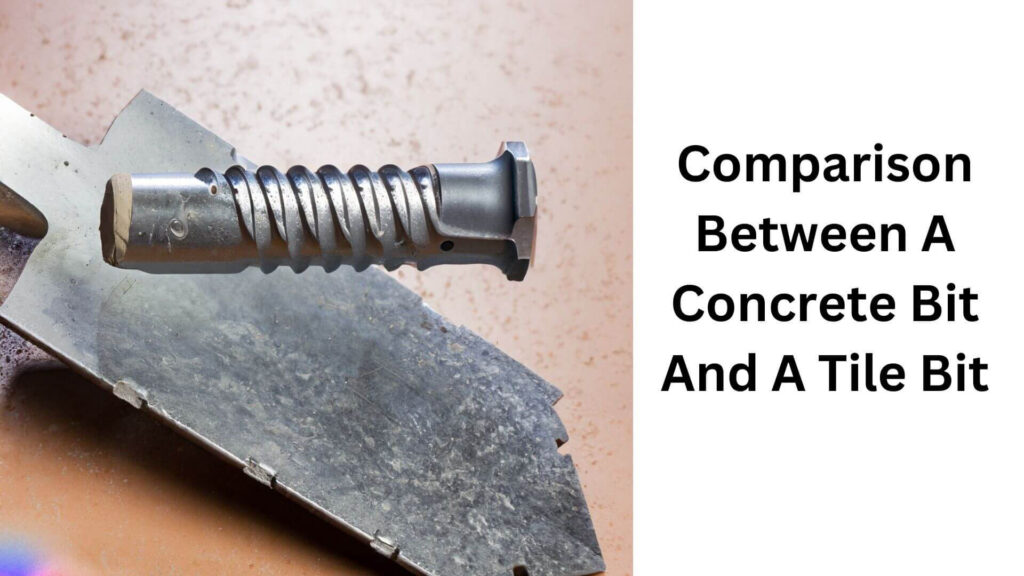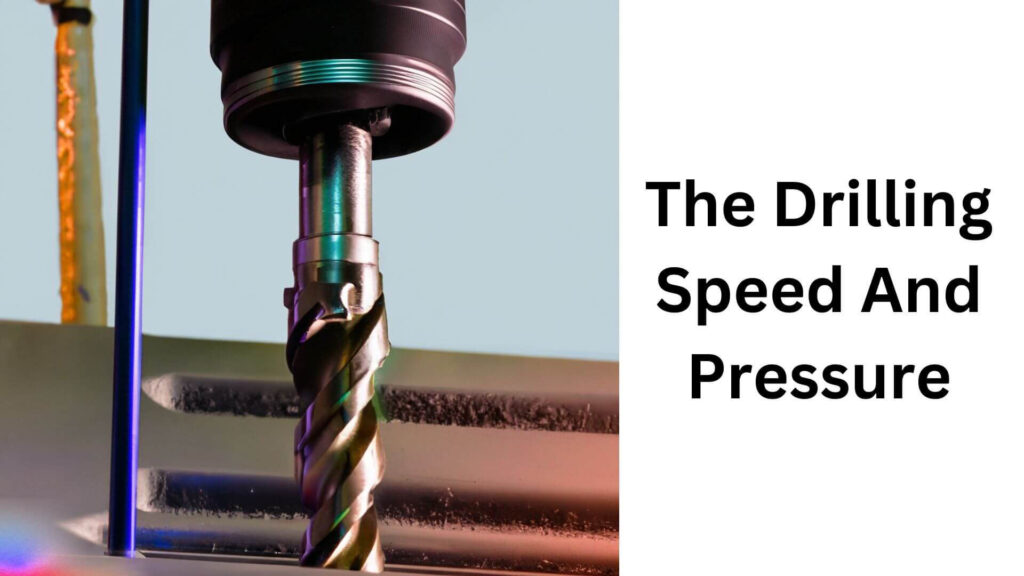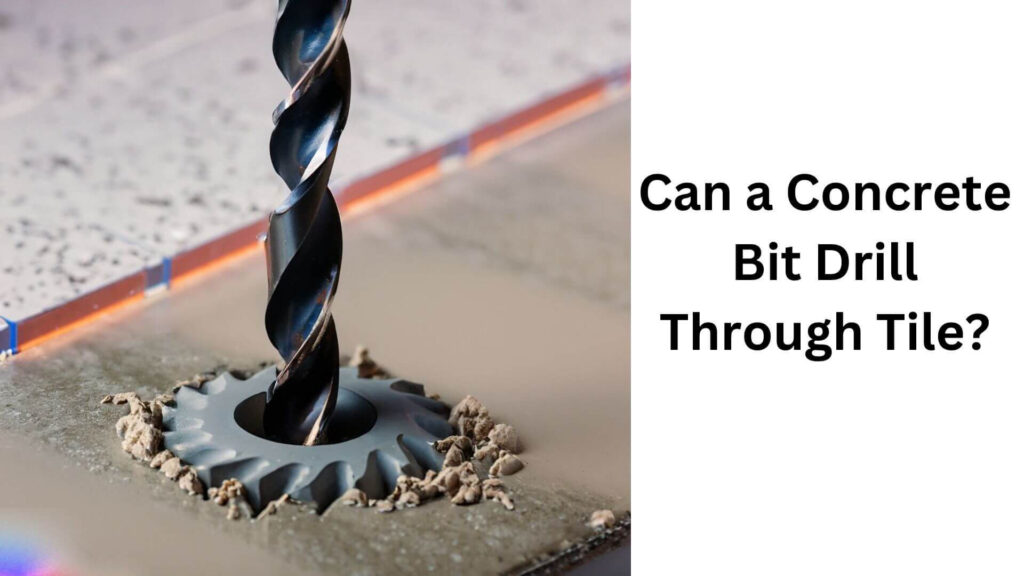Are you facing the daunting task of drilling through delicate tiles but need to know if a concrete bit is up to the challenge? Look no further as I delve into the intriguing question: Can a concrete drill bit through tile?
The short answer is: A concrete bit can drill through the tile, but special care and equipment are required. Using a regular drill bit can cause the tile to crack or shatter.
A diamond-tip drill bit and applying consistent pressure while using water to keep the tile and bit cool is recommended to avoid damage.
Additionally, it is essential to wear safety glasses and gloves during the drilling process.
Drilling through tile is necessary when installing towel racks, shower heads, or other bathroom accessories.
Homeowners and DIY enthusiasts can successfully drill through tile using the proper technique and equipment without causing damage or injury.
Table of Contents
Understanding The Different Types Of Drilling Bits
1. Overview Of The Various Types Of Drilling Bits
Drilling bits come in various shapes and sizes, each designed for a specific material. The most common drilling bits are masonry bits, tile bits, wood bits, and metal bits. A drilling bit designed for softwood may perform poorly when used on a hard material like tile or concrete.
Therefore, having the right drilling bit for the job at hand is essential. Some drilling bits, such as carbide-tipped, can be used on multiple materials.
However, even these bits have limitations, and it is essential to follow the manufacturer’s recommendations for the type of material the bit can drill.
2. Comparison Between A Concrete Bit And A Tile Bit

Concrete bits and tile bits may seem similar but have differences in design and construction that make them suitable for specific materials.
- Concrete bits are designed for drilling holes in concrete, brick, and stone. They have a fluted shank, which helps evacuate debris from the hole while drilling. The tip of these bits is made of tungsten carbide, making them suitable for drilling into hard materials.
- Tile bits, on the other hand, are designed specifically for drilling through tile. They have a spear-shaped tip preventing the bit from skidding on the tile’s smooth surface. Unlike concrete, tile bits do not have a fluted shank, so the debris gets trapped in the hole while drilling.
3. Differences In Bit Design And Construction
The difference in the design and construction of concrete and tile bits directly impacts their performance on specific materials.
- Concrete bits have a longer flute length than tile bits, allowing them to drill deeper holes into hard materials. They also have a wider fluted shank, which provides a stable platform for drilling and reduces the risk of bending or breaking.
- As previously mentioned, tile bits have a spear-shaped tip that helps start a hole in the tile without slipping. They have a shorter flute length and a narrower shank than concrete bits, making them suitable for drilling shallow holes.
Choosing the right drilling bit is crucial to get the desired results. While concrete and tile bits may seem similar, their design and construction differences make them suitable for specific materials.
Always follow the manufacturer’s recommendations for the type of bit for a specific material to achieve the best results.
Read More: Can You Sharpen a Concrete Drill Bit?
4 Factors That Determine Whether A Concrete Bit Can Drill Through Tile
Are you planning to tile your bathroom or kitchen floor? Have you ever considered using a concrete drill bit to tackle this task?
As tempting as it may seem to use a concrete bit to drill through your tiles, it is essential to consider several factors to ensure the success of your drilling project.
1. The Type And Thickness Of The Tile
The type and thickness of the tile is the first factor to consider when drilling through it with a concrete bit.
Different tiles, such as ceramic, porcelain, or natural stone, have varying degrees of toughness, affecting the bit’s ability to penetrate.
Similarly, thick tiles may require a more robust drilling bit, which can resist wearing down over time, leading to ineffectiveness. Therefore, selecting a bit that can handle your tile’s specific type and thickness is essential.
2. The Hardness And Density Of The Tile
Apart from type and thickness, the hardness and density of the tile are also fundamental factors to consider when drilling through it with a concrete bit.
More intricate tiles, such as natural stone or porcelain, can be more challenging to penetrate, requiring a much stronger bit.
The tile’s porosity will also affect how easily it can be drilled. Less dense tiles will make drilling much smoother as they are less likely to crack or break.
3. The Condition And Quality Of The Drilling Bit
The condition and quality of the drilling bit also play a vital role when drilling through tile. A dull or worn-out bit will not drill effectively, resulting in poor drilling quality or even bit failure.
Quality drilling bits typically last longer, resist wear and tear, and are made from more robust materials, ensuring more satisfactory results.
4. The Drilling Speed And Pressure

Drilling through tile requires a slow and steady pace – high speed can result in tile fracture or cracking. Applying too much pressure can also have the same effect. Therefore, it is essential to moderate the drilling pressure and speed to achieve the best results.
Monitoring drilling speed and pressure will help you to avoid any damage to your tiles.
Considering the above factors, you can handle tiling projects like a pro. Remember to select a drilling bit compatible with the type and thickness of your tile, use a high-quality drilling bit, and adjust your drilling speed and pressure to prevent tile cracking.
Read More: Are Titanium Drill Bits Good for Concrete?
Techniques For Drilling Through Tile With A Concrete Bit
Tiles are popular for walls, floors, and backsplashes in homes and commercial spaces. Drilling through tiles can be challenging, and using the wrong drill bit can result in tile damage or even cracking. However, you can quickly drill through tiles with the proper technique and drill bit.
1. Preparing The Tile Surface For Drilling
Before drilling through tiles, it’s crucial to prepare the surface correctly.
- Clean the tile surface to remove any dirt, dust, or debris.
- Mark the drilling spot with a pencil or marker.
- Use masking or painter’s tape to cover the area where you’ll be drilling. This will prevent the drill bit from slipping and also help protect the tile’s surface from chipping.
2. Proper Drilling Technique
The way you drill through tiles can significantly impact the outcome.
- Use a low-speed setting on your drill to avoid damaging the tile.
- Apply consistent, gentle pressure as you drill. Avoid using too much force, as it can cause the tile to crack.
- Start drilling at a slight angle to create a divot in the tile’s surface. Then, straighten to a vertical position to continue drilling. This approach will help prevent the drill bit from slipping across the tile’s surface.
3. Using A Guide To Ensure Accuracy
Using a guide is essential when drilling through tiles to ensure accuracy.
- Use a nail and hammer to create a small dent in the center of the marking.
- Place a guide over the marking, such as a wooden block or a tile hole saw.
- Slowly drill through the hole saw or guide until the desired depth is reached.
4. Cooling And Lubrication
Cooling and lubrication are essential when drilling through tiles.
- Use water as a coolant to keep the drill bit’s temperature low. You can use a wet sponge or towel to cool while drilling continuously.
- Apply a small amount of lubricant to the drill bit before drilling. This will help the bit move through the tile smoothly and reduce the risk of cracking or damage.
Drilling through tiles with a concrete bit can be done successfully with the proper technique, preparation, and tool. Remember to use a low-speed setting, apply consistent pressure, and use a guide to ensure accuracy.
Following these tips, you can quickly and effectively drill through tiles without damaging or cracking them.
Check Also: Some Awesome Drills for Concrete Walls.
Precautions And Safety Measures
1. Importance Of Using Safety Equipment
When drilling through tile, it is essential to use the correct safety gear to protect you from any potential harm.
- Safety goggles: To shield your eyes from any debris or dust that may arise during the drilling process.
- Dust mask or respirator: To prevent inhaling small particles and dust.
- Gloves: To safeguard your hands and fingers from cuts or abrasions.
- Earplugs or earmuffs: To protect your hearing from the loud noise of the drill.
It is also essential to wear appropriate clothing, such as long-sleeved shirts and pants, to protect your skin from potential injury.
2. Risks Involved With Using Power Tools
Power tools can be dangerous and pose several potential risks if misused.
- Electrical hazards: Using damaged or malfunctioning electrical equipment can lead to shocks and electrocution.
- Injuries due to moving parts: The drilling bit in a concrete drill has a rotating component that can cut and injure anyone in close proximity.
- Kickbacks: While drilling, the drill bit’s larger size and speed can cause kickbacks; this can be dangerous to the user’s safety.
- Risk of objects flying off: Prone to damaging the tile, the drill bit can cause chips or other debris to fly off unexpectedly.
3. Precautions To Prevent Damage To The Tile And Bit
To prevent any damage to your tile or concrete bit, you should take the following precautions:
- Start drilling slowly: Starting the drill at a slow speed and gradually increasing speed helps to prevent any damage to the tile.
- Use the right bit size: Using the correct size bit is essential in preventing damage to the tile. A bit that’s too large may result in cracking or chipping, while a bit that’s too small may not get the job done.
- Use a lubricant: Using a lubricant, such as water, helps to keep the bit cool and reduces the risk of overheating and damaging the tile.
- Avoid exerting too much pressure: Applying too much pressure during drilling may crack the tile. Remember to let the bit do the work and not force it.
- Keep the drill bit clean: Clean the drill bit frequently to prevent any buildup of debris that may affect its accuracy and performance.
By adhering to these precautions and safety measures, you can ensure that you drill through the tile safely and effectively while preventing damage to both the tile and the drill bit.
Frequently Asked Questions For Can A Concrete Bit Drill Through Tile?
Can A Concrete Bit Drill Through Tile?
Yes, a concrete bit can drill through tile, but using a tile bit is recommended for accuracy and avoiding cracks.
What Is The Difference Between A Concrete Bit And A Tile Bit?
A concrete bit has a pointed tip for drilling through hard materials, whereas a tile bit has a flat tip for precision and preventing cracks in delicate surfaces.
How Do I Prevent Cracking When Drilling Through Tile?
Use a low speed on your drill and apply light pressure to prevent cracking. Additionally, use a tile bit instead of a concrete bit.
Can I Use A Regular Drill Bit To Drill Through Tile?
No, a regular drill bit is not designed for drilling through the tile and can cause cracking. Use a tile bit for best results.
What Is The Best Way To Drill Through Tile Without Cracking It?
Use a tile bit with a low-speed drill and water cooling system. Place masking tape over the tile and use light pressure to avoid cracks.
Final Thoughts
Based on the above discussion, it is evident that a concrete bit can drill through tile, but with specific considerations. The right equipment and technique are crucial to prevent damage and achieve desired results.
Remember to choose the right size, type, and quality of the bit, lubricate the tile surface, and apply gentle pressure while drilling.
Additionally, ensure that you work with a steady hand to prevent slip-ups and accidents. It is also worth noting that personal protective equipment like gloves and goggles should always be worn.
Incorporating these tips allows you to successfully drill through tile using a concrete bit without unnecessary damage or challenges.
Therefore, ensure you understand the techniques and precautions outlined in this article to get the job done effectively and apply them during your next project.

Hey, I am MD Hrithik Hossain, I’m a huge fan of DIY crafts. My workshop is where I spend most of my spare time, and I’m always working on some project. To that end, I’d like to share some of my knowledge and experience with you in power tools, woodworking, and other specialized materials fabrication.
I will guide you with genuine knowledge that can assist you with deciding whether a drill is appropriate according to your requirements or not. If you want to find the best drill and know which type of drill is most suited for your needs, then I can guide you with my expertise. My passion lies in helping others find the correct products they need at an affordable price.


